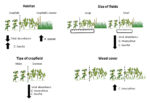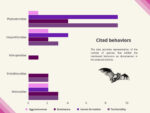Helmintos de Didelphis albiventris y Didelphis aurita (Mammalia, Didelphimorphia) en ambientes selváticos y antrópicos en el departamento Iguazú, Misiones
Bárbara Hartmann
Revista Científica SAREM–SBMz



Carnivorans are vital for ecosystem functioning and are one of the main groups used for conservation purposes. However, some species receive less attention than others. As many ecological aspects of South American carnivorans are unknown, the distribution range becomes of primary importance for conservation use. We aimed to analyze the distribution of terrestrial carnivorans in Uruguay, yielding an updated database and including a temporal dimension of distribution changes. We searched the main collections of mammals and bibliographic references for carnivorans in Uruguay. We divided the records according to temporal provenance and analyzed the changes in knowledge of distributions according to time. We also analyzed species and family richness for actual times with a 25 × 25 km grid. Finally, we studied the possible bias in data gathering related to roads. We ensembled the most complete database for carnivoran distribution in Uruguay, with 1905 records. The country had a total species richness of 16, varying with time according to local extinctions and new records of different species. The most common species was Cerdocyon thous, while the least recorded was Nasua nasua. The jaguar Panthera onca has been extinct since historical times, while Pteronura brasiliensis has probably been extinct since actual times. The areas with higher species richness were located in the northeastern, south, and southeastern parts of the country. A bias in data gathering was present, marked by the proximity to roads. Finally, protected areas in Uruguay showed a different proportion of protected species, regardless of their surface.
Carnívoros de Uruguay: distribución actualizada y cambios a través del tiempo. Los carnívoros son vitales para el funcionamiento de los ecosistemas, y son uno de los grupos más usados para los objetivos de conservación. Sin embargo, muchas especies reciben más atención que otras. Como existen diversos aspectos ecológicos de carnívoros sudamericanos que se desconocen, los rangos de distribución son esenciales para las categorizaciones de conservación. Analizamos la distribución de los carnívoros terrestres en Uruguay para generar la base de datos más actualizada a la fecha, y estudiar los cambios temporales. Se relevaron especímenes de colecciones biológicas y referencias bibliográficas. Se dividieron los registros acorde a su proveniencia temporal y se analizaron los cambios en su distribución. Además, se analizó la riqueza de especies y familias, con una grilla de 25 × 25 km. Finalmente, se estudió el posible sesgo en la colecta de datos acorde a la cercanía de rutas. Se generó la base de datos más completa a la fecha, con 1905 registros. Uruguay tuvo una riqueza específica de 16, que ha variado, según el tiempo,con extinciones y nuevos registros. La especie más registrada fue Cerdoyon thous, mientras que la menos registrada fue Nasua nasua. El jaguar Panthera onca se encuentra extinto desde tiempos históricos, mientras que Pteronura brasiliensis se encuentra posiblemente extinta desde tiempos actuales. Las áreas con mayor riqueza se encontraron en las partes noreste, sur y sureste del país. Se encontró un sesgo en los datos, marcado por la cercanía a las rutas. Finalmente, las áreas protegidas mostraron una diferente proporción de especies protegidas, independientemente de su superficie.

Ctenomys talarum (peso corporal ∼150 g) puede morder con los incisivos con una fuerza mayor de 3 kgf, por lo que estas piezas dentarias soportan un esfuerzo (fuerza de reacción) unas 20 veces mayor que su peso corporal. Las fuerzas de reacción que reciben los dientes al morder son transmitidas al resto del cráneo por los huesos y otros tejidos que lo constituyen. ¿Cómo se comporta estructuralmente el cráneo ante estos esfuerzos? Mediante el análisis de elementos finitos se estimó la tensión en el cráneo de C. talarum ante fuerzas de mordida aplicadas tanto sobre los incisivos superiores, al simular la acción de roer, como sobre el premolar 4 superior, al simular la trituración de alimentos. La mordida con incisivos produjo una tensión elevada en la cavidad glenoidea y en la arcada cigomática, de 47,8 y 17,8 megapascales (MPa), respectivamente. La masticación unilateral (i.e., fuerza aplicada sobre el premolar 4 de un único lado del cráneo) generó valores de tensión relativamente mayores, comparados con los de roedura, entre los que se destacan los incrementos en la barra preorbitaria y en la arcada cigomática, con valores de 27,5 y 31,5 MPa, respectivamente. En ambas simulaciones de mordida, los factores de seguridad (i.e., cociente entre la capacidad máxima de soporte estructural y el esfuerzo real al que se ve sometido el cráneo) fueron elevados, y ningún valor fue inferior a 3. Los valores de tensión disímiles entre regiones equivalentes a derecha e izquierda, alternadamente mayores de uno u otro lado a lo largo del cráneo y durante la masticación unilateral, sugieren la existencia de un esfuerzo de torsión que actúa sobre el eje longitudinal del cráneo.
Structural analysis of the skull of the talas’ tuco tuco, Ctenomys talarum (Rodentia, Caviomorpha) under bite efforts. An incisor bite by a talas’ tuco tuco (Ctenomys talarum, body weight ∼150 g) may reach values over 3 kgf so that the incisor supports an effort (reaction force) about 20 times greater than the body weight of the animal. Reaction forces that teeth locally receive while biting are transmitted to the rest of the skull by the bones and other constitutive tissues. Thus, a question arises about how the skull structurally behaves at facing these mechanical stresses. Finite element analyses were used to estimate stresses in the cranium of C. talarum under biting efforts on either the upper incisors when simulating gnawing, or the upper premolar 4 when simulating grinding foods. Incisor biting produced relatively high stresses in the glenoid cavity and in the zygomatic arch, 47.8 and 17.8 megapascals (MPa), respectively. Unilateral chewing (i.e., force being applied to premolar 4 only on one side of the skull) yielded relatively higher stress values compared to gnawing. Increases in stress at the preorbital bar and the anterior region of the zygomatic arch stand out, with values of 27.5 and 31.5 MPa, respectively. In both biting simulations, safety factors (i.e., the quotient between the maximum structural capacity and the real stress produced by loadings upon the cranium) were high, not observing any value lower than 3. Dissimilar stress values between equivalent left- and right-sided regions, being alternatively higher on one side or the other across the skull and during unilateral chewing, suggest the existence of torsional forces acting along the longitudinal axis of the skull.

Dentro de las subpoblaciones de guanacos (Lama guanicoe), algunas se encuentran en peligro crítico de extinción. Es el caso particular del guanaco chaqueño, que habitó amplias extensiones de esta gran ecorregión hasta principios del siglo XX. A partir de información que ubicaba a la especie en la región de las Salinas Grandes del centro de Argentina, se realizó un estudio transdisciplinar. Después de siete años de muestreos, se caracterizó la historia reciente de esta población, se estimó su tamaño y el área de su distribución. En la actualidad, el número de guanacos que persiste es inferior a los 80 individuos, y se encuentran restringidos a un área peri-salina y zonas aledañas de un gran campo ganadero que prohíbe su cacería, principal impacto antrópico que redujo a esta población en el pasado reciente. Si bien existen aspectos alentadores para su conservación, como la reciente creación del Parque Nacional Traslasierra, es necesario profundizar las medidas de manejo tendientes a aumentar el tamaño y la distribución del guanaco chaqueño, así como también generar acciones que permitan revalorizar su existencia como recurso biocultural.
Conservation status of the last guanacos’ Chaqueñan population in Argentina: a transdisciplinary approach. Within the subpopulations of guanacos (Lama guanicoe), some are in critical danger of extinction. This is the case of the Chaqueñan guanaco, which inhabited large areas of this great ecoregion until the beginning of the 20th century. Based on the information that located the species in the Salinas Grandes of central Argentina, a transdisciplinary study was conducted. After seven years of field studies, the recent history of this population was characterized, and its population size and area of distribution were estimated. Currently, the number of guanacos that persists is less than 80 individuals, being restricted to the peri-saline and surrounding areas of a large cattle ranch that prohibits hunting, the main anthropic impact that reduced this population in the recent past. Although there are encouraging aspects for its conservation, such as the recent creation of the Traslasierra National Park, it is necessary to deepen management measures to increase the size and distribution of the Chaco guanaco, as well as generate actions that allow revaluing its existence as a biocultural resource.

Changes in land use in the Pampean region have led to an increase in pastures and cultivated fields and a decrease in native grasslands, which mainly remain at the borders of cultivated fields. In the province of Buenos Aires, there is a trend to increase the size of fields, eliminate the edges between them, and increase the proportion of the area cultivated with soybeans. Borders function as corridors and refuges for native fauna, so this reduction may affect rodent abundance, although this effect may vary according to the habitat affinities of the species. Our goal was to evaluate the effect of the size of fields and the decrease in the proportion of border habitats on the rodent community. The study was conducted in the province of Buenos Aires, in Central Argentina. Rodents were surveyed in 12 fields and their borders. Overall rodent density and both species of Calomys showed negative effects of field size on their abundance, while for A. azarae there were no significant effects. Calomys laucha was more abundant in maize crop fields, and Calomys musculinus did not show an effect on habitat, but its abundance in crop fields increased with weed cover. Akodon azarae showed strong habitat selection for borders. In summary, changes in the agricultural landscape with an increase in cropland at the expense of natural and semi-natural habitats affect rodent communities, and this effect would have consequences through their trophic interactions, both as consumers of plant and insect species as well as food sources for mammalian and avian predators.
Determinantes de la abundancia de roedores en paisajes agrícolas de Argentina central. Los cambios en el uso de la tierra en la región Pampeana han conducido a un aumento de pasturas y campos cultivados y a una disminución de pastizales nativos, los cuales permanecen principalmente en los bordes de campos. En esta región existe una tendencia al aumento en el tamaño de los campos, a la eliminación de los bordes entre ellos y a un aumento en la proporción del área cultivada con soja. Los bordes funcionan como corredores y refugio para la fauna nativa, por tanto, su reducción puede afectar a la abundancia de roedores, dependiendo de las afinidades de hábitat de cada especie. Nuestro objetivo fue evaluar el efecto del tamaño de los campos y de la disminución en el área relativa de los bordes. El estudio se realizó en la provincia de Buenos Aires, Argentina central. Se muestrearon 12 campos y sus bordes. La abundancia total de roedores y las de ambas especies de Calomys mostraron efectos negativos del tamaño de los campos. Calomys laucha fue más abundante en los campos de cultivo de maíz, mientras que la abundancia de Calomys musculinus en campos aumentó con la cobertura de malezas. A. azarae mostró fuerte selección por los bordes. En resumen, los cambios en el paisaje agrícola, con un aumento de las áreas cultivadas a expensas de ambientes naturales y seminaturales, afecta a las comunidades de roedores y este efecto puede trasladarse a otros niveles tróficos, debido a su papel como consumidores de plantas e insectos y como fuente de alimento para aves y mamíferos predadores.

Yangochiroptera is a suborder recognized for having diversified food habits and unique social behavior. Based on a literature review, this study analyzed the inter-specific variation present in their social behavior, with an emphasis on dominance behavior. Harem formation, territoriality, and aggressiveness were shown to be connected to dominance behavior. The polygyny of defense of resources and defense of harem females appeared as mating systems in which the possibility of dominance appears to be greater. However, the small number of references dedicated specifically to this type of behavior makes it difficult to describe the patterns, and more studies focusing on the behavioral ecology of their species are needed.
Relações de dominância em Yangochiropteros: uma revisão. Yangochiroptera é subordem reconhecida por apresentar hábitos diversificados em relação à sua alimentação e também aos seus comportamentos sociais únicos. A partir de uma revisão bibliográfica, este estudo buscou analisar a variação interespecífica no comportamento social desse grupo — com ênfase em comportamentos de dominância. Formação de haréns, territorialidade e agressividade mostraram estar conectados ao comportamento de dominância. Já a poliginia de defesa de recursos e de defesa de fêmeas de harém, apareceram como sistemas de acasalamento nos quais a possibilidade da dominância aparenta ser maior. Contudo, o baixo número de referências voltadas especificamente para este tipo de comportamento dificulta a descrição de padrões, sendo necessários mais estudos focados na ecologia comportamental de suas espécies.

In paleontology and also in archaeology, a direct comparison between the dentition of extant mammal species with known diets is currently used to infer the feeding habits of their ancient relatives. It is assumed, by analogy, that both species specialized in similar food, and determining the diet of a fossil mammal is helpful to identify the environmental context in which the animal inhabited. This type of approach allows us to know aspects of both the animals and the human groups that could benefit from hunting these animals, such as their behavior, environment, feeding preferences, and important events in their life history. At the same time, they provide a better knowledge of human palaeoecology, subsistence, and behavior. For these reasons, it is important to rely on modern data that allows this kind of approach. The aim of this paper is to establish baseline data to use in paleoecological studies from similar environments by studying the diet of an extant population of white-tailed deer (Odocoileus virginianus cariacou) from El Tuparro National Natural Park (PNN–El Tuparro) in Colombia. For this purpose, we used tooth mesowear and microwear as dietary proxies, which indicate the average annual diet and the diet at the time of death, respectively. The diet analysis of a deer extant population at the PNN–El Tuparro evidence that they consumed shrubs and herbs from both forests and savannas, but their diet changed seasonally. Tooth mesowear evidence of a grass-dominated diet in the last years of life and microwear browser diet at the moment of the death of the examined individuals.
Inferencias sobre los hábitos alimenticios de una población de venado de cola blanca (Odocoileus virginianus cariacou) a partir del desgaste dental en un área protegida de la Orinoquia colombiana. En paleontología y también en arqueología se realiza una comparación directa entre la dentición de especies actuales con dietas conocidas para inferir los hábitos alimenticios de especies de mamíferos en el pasado. Por analogía se asume que ambas especies se especializaron en alimentos parecidos. Al determinar la dieta de un animal fósil se está conociendo el medioambiente y el tipo de ecosistema donde vivió. Este tipo de aproximación permite conocer aspectos tanto de los animales como de los grupos humanos que pudieron beneficiarse de su caza. Aspectos de los animales, como su comportamiento, entorno, preferencias alimentarias y eventos importantes de la vida pueden ser estudiados. También proporcionan un mejor conocimiento de la paleoecología, la subsistencia y el comportamiento humanos. Por estas razones, es importante contar con datos actuales que permitan esta clase de inferencias. El objetivo de este trabajo es establecer una línea base para usar en estudios paleoecológicos en ambientes similares a partir del estudio la dieta de una población actual de venado cola blanca (Odocoileus virginianus cariacou) del Parque Nacional Natural El Tuparro (PNN–El Tuparro) en Colombia. Para tal fin utilizamos el mesodesgaste y el microdesgaste dental como técnicas. El análisis de la dieta evidencia que estos venados consumían arbustos y hierbas del bosque y también de las sabanas, y que su consumo estaba relacionado con la temporada. El mesodesgaste muestra un tipo de dieta dominada por el pastoreo en los últimos años de la vida de los individuos, mientras que el microdesgaste evidencia una tendencia al ramoneo en el momento de la muerte de los animales.

